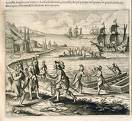One of the World's Leading
Sources of Information On Literature, the Arts, and a Wide Range of
Subjects
Brereton's Story
(This is taken from John D. Baldwin's Ancient America, originally published in 1871.)

Those who seek to identify the Mound-Builders with the barbarous Indians find nothing that will support their hypothesis. Nevertheless, some of them have tried very strangely to give it aid by one or two quotations from early voyagers to America. The most important are taken from Brereton’s account of Gosnold’s voyage in 1602. The following occurred on the coast of Maine:
“Eight Indians, in a Basque shallop, with mast and sail, an iron grapple, and a kettle, came boldly aboard us, one of them appareled with a waistcoat and breeches of black serge, made after our sea fashion, hose and shoes on his feet: all the rest (saving one that had a pair of breeches of blue cloth) were naked.”
It is known that the Basques were accustomed to send fishing vessels to the northeastern coast of America long before this continent was discovered by Columbus. They continued to do this after the discovery. These Indians had evidently become well acquainted with the Basques, and, therefore, did not fear to approach Gosnold’s ship. Probably some of them had been employed on board Basque fishing vessels. Certainly their boat and apparel came from the Basque fishermen, and did not show them to be Mound-Builders. Of the Indians on the coast of Massachusetts, Brereton says:
“They had great store of copper, some very red, some of a paler color; none of them but have chains, earrings, or collars of this metal. They had some of their arrows herewith, much like our broad arrow-heads, very workmanly made. Their chains are many hollow pieces cemented together, each piece of the bigness of one of our reeds, a finger in length, ten or twelve of them together on a string, which they wear about their necks: their collars they wear about their bodies like bandoliers a handful broad, all hollow pieces like the other, but somewhat shorter, four hundred pieces in a collar, very fine and evenly set together.” He adds: “I am persuaded they have great store (of flax) growing upon the main, as also mines and many other rich commodities, which we, wanting time, could not possibly discover.”
If all this had been true, it would not serve the purpose for which it is quoted; for remains of the Mound-Builders have never existed in Massachusetts, and we should necessarily suppose these Indians had procured copper and copper ornaments by trading with the Basques or with other French voyagers. If only one or two Indians had been represented as wearing ornaments made of copper, this explanation could be readily accepted. But he avers that they had “great store of copper,” and adds, “None of them but have chains, earrings, or collars of this metal.” Therefore his statement is incredible. The following considerations will show why it must not be regarded as honest, unadorned truth.
1. Those interested in Gosnold’s voyage aimed to establish a colony on that coast; and all who served them, or were controlled by them, were easily moved to tell seductive stories of the country “upon the main.” The chief aim of Brereton’s account of this voyage was to incite emigration. Therefore he gave this wonderfully colored account of mines, flax-growing, copper chains and collars, and “other rich commodities” among the wild Indians of Massachusetts. Settlements on that coast, it was believed, would bring profit to those in whose interest he wrote. Gosnold actually proposed at that time to establish a colony on one of the islands in Buzzard’s Bay, and had with him twenty men who were expected to stay as colonists, but finally refused to do so. He saw a great deal of the Indians, and knew much more of their actual condition than the story admits.
2. Eighteen years later the Pilgrims landed at Plymouth from the
Mayflower. Neither copper mines nor flax fields were then known in
Massachusetts. No Indians with “great store” of copper and flax, and
covered with copper ornaments, were seen or heard of by the Pilgrims,
either at that time or afterward. In 1602, Brereton, or any other writer
employed to write in such a way as would promote emigration, could tell
such stories, and romance freely concerning the Indians, without fear of
contradiction. Afterward, when the actual barbarism of the Indian tribes
in New England and other parts of the country had become generally
known, no one could describe any of these Indians as successful miners
and flax-growers, and assert gravely that they had such stores of copper
that “none of them” lacked great abundance of copper “chains, earrings,
collars,” and the like, without being laughed at. Brereton’s story must
be regarded as an invention designed to serve a special purpose, but not
warranted by any thing seen during the voyage he describes. Neither in
New England nor any where else in our part of the continent did the
early colonists find Indians who worked copper mines and had “great
store of copper.” What Brereton says was not true of any Indians known
to our first colonists or to their successors. It corresponds to no
reality found in any part of our territory during the last two hundred
and fifty years. Therefore, to use his story in support of an absurd
hypothesis is not a satisfactory proceeding.
Home | Book Collecting | Folklore / Myth | Philately | Playing Cards | Literature | Contents
